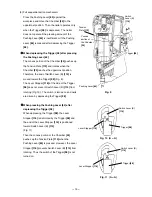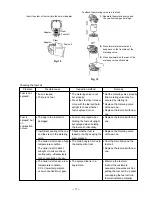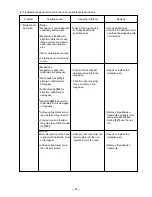
--- 10 ---
8. MECHANISM AND OPERATION PRINCIPLE
8-1. Mechanism
The Model NR 90GC is a nailer that drives nails into workpieces with the aid of fuel combustion energy. This is
the Hitachi's first gas strip nailer and there is no similarity between the Model NR 90GC and other Hitachi nailers
in construction. Its principle of operation is completely different from that of a pneumatic nailer except the
magazine section. The Model NR 90GC is equipped with a fuel cell and a battery in order to output combustion
energy in addition to the electric components such as electric circuits, motor and electric switches.
As illustrated in Fig. 8, the Model NR 90GC can be generally divided into three sections: Output section, head
section and handle section. Features of the main parts are described below.
Output section (Housing section):
This section outputs fuel combustion energy. The piston reciprocates to drive nails in the same manner as a
pneumatic nailer. The piston reciprocates in the cylinder. Under the piston, there is a driving unit. The
combustion chamber is encased in a chamber and burns fuel to output combustion energy. Outputted
combustion energy is applied to the top of the piston then the piston is suddenly lowered to drive nails at the
driving unit. The nails are fed from the magazine unit in the handle section.
Head section (Cylinder head section):
This section is at the top of the combustion chamber in the output section. There is a fan to stir fuel and fuel is
fed from the fuel cell to the combustion chamber in this section. The fan is mounted to the motor.
The motor is held in the motor mount and secured to the center of the cylinder head through the spring.
This spring absorbs shock to the motor. There is a spark plug beside the fan. The top cover at the top of the
main body covers the filter. The cell lever feeds fuel from the fuel cell to the combustion chamber. Its rotation
is supported.
Handle section:
This section is comprised of a magazine unit to feed nails to the driving unit, battery holder, handle unit, fuel
cell holder and electrical wiring. The construction of the magazine unit is similar to that of a pneumatic nailer.
There is a controller behind the magazine unit in order to control electric signals. The handle unit contains a
trigger with a built-in spark switch. Switch lever (B) is located at the top of the trigger in order to turn on the
spark switch. The electrical wiring connects the battery, trigger switch and fan switch. Upon receipt of each
switch signal by the controller, the motor in the head section rotates and the spark plug discharges.














































